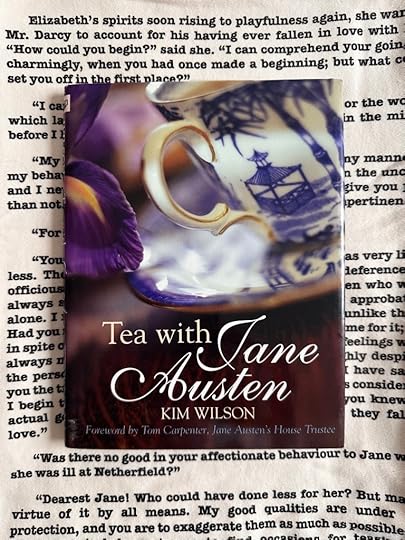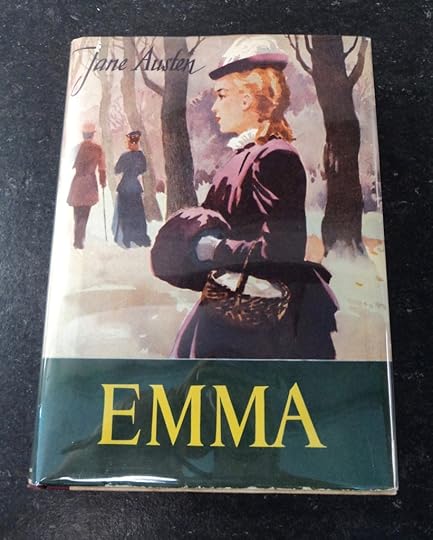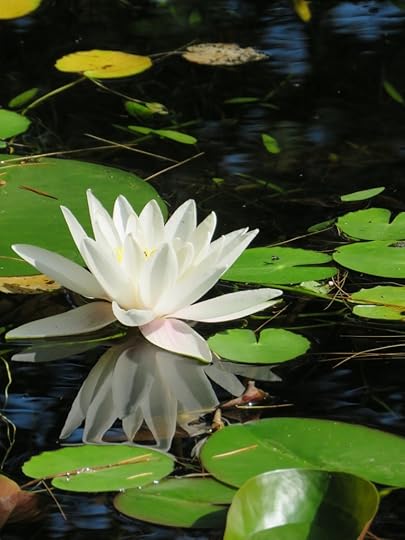Sense and Enthusiasm
Happy 248th birthday to Jane Austen!

Last summer’s roses in the Historic Gardens at Annapolis Royal, photographed by Brenda Barry
To celebrate, I thought I’d write about an Austen-inspired novel I read recently. Polly Shulman’s novel Enthusiasm is a delightful YA romance inspired by Jane Austen’s Pride and Prejudice, but also by less well-known elements of Jane Austen’s life and work, including a novel written by her niece Anna that was originally entitled “Enthusiasm” and later renamed “Which is the Heroine?” In a letter to Anna, Jane said, “I like the name ‘Which is the Heroine’ very well, and I daresay shall grow to like it very much in time; but ‘Enthusiasm’ was something so very superior that my common title must appear to disadvantage” (August 10, 1814). I missed Shulman’s novel when it was published back in 2006, and I’m grateful to my friend Lisa for giving me a copy.

“There is little more likely to exasperate a person of sense than finding herself tied by affection and habit to an Enthusiast,” says the narrator, Julia Lefkowitz, lamenting the extremes of her best friend and next door neighbour Ashleigh Rossi’s various enthusiasms, the latest of which is “the joys of Miss Austen’s work.” Usually, Julia follows where Ashleigh leads, but in this case, she has introduced Ashleigh to Jane Austen, and soon the Enthusiast is attempting to dress like an Austen heroine, addressing Julia as “my dear Miss Lefkowitz,” and plotting to find heroes for both of them by crashing the fall formal at a nearby prep school for boys, or, rather, “young gentlemen.” And Julia is worried that Ashleigh’s passion for Austen will overshadow her own. Nevertheless, she agrees to her friend’s plan, and with the convenient assistance of two young men who agree to act as their escorts, they attend the formal and begin to fall in love.
The problem, however, is that they can’t agree which of the young men is Mr. Bingley, and which is Mr. Darcy, or which of them is Jane Bennet or Elizabeth Bennet. Despite the contrast Julia draws between herself as the sensible one and Ashleigh as the Enthusiast, it doesn’t seem to have occurred to her that they might be Elinor and Marianne Dashwood, rather than Jane and Elizabeth.
I loved the names and nicknames in this novel. One of the young men, for example, is named Charles Grandison Parr, presumably after the hero of one of Austen’s favourite novels, The History of Sir Charles Grandison, by Samuel Richardson. Another student at the prep school is named Alcott Fish. The public school Julia and Ashleigh attend is called Byzantium High, and the school’s literary magazine is Sailing to Byzantium. And Julia thinks of her stepmother, Amy, as the “Irresistible Accountant,” or “I.A.” for short.
I also appreciated the way poetry is part of the way these teenagers communicate with each other, whether they’re analyzing speeches from Romeo and Juliet, accidentally speaking in iambic pentameter, pinning poems to the oak tree between Julia’s house and Ashleigh’s, or discussing assonance, alliteration, or acrostics. I don’t know how many teenagers actually talk this way, but it’s certainly fun to read about.
There are a few more Austen-related things I’d like to share with you today. First, a lovely paragraph from a blog post that Ellen Moody wrote a few years ago, in which she draws a comparison between the way she reads Elizabeth Bishop’s poetry and the way she reads Jane Austen’s novels. She writes that in Bishop’s “Sonnet” (1928) she finds “Bishop keeping herself calm by making order and harmony through making a poem which can harness the very rhythms of her heartbeat and body as she writes and we read it. This is the way I read Jane Austen’s novels, say Emma: the orderly rhythm of her sentences, their elegance and deeply felt content within patterns soothes and keeps me calm, strengthens me. This is what Bishop is doing through her very finger-tips, her lips, her whole body healing.” The poem opens with a “need of music that would flow / Over my fretful, feeling finger-tips, / Over my bitter-tainted, trembling lips, / With melody deep, clear, and liquid-slow.”
Ellen wrote a beautiful guest post for the blog series I hosted for the 200th anniversary of Austen’s Northanger Abbey and Persuasion: “‘For there is nothing lost, that may be found’: Charlotte Smith in Jane Austen’s Persuasion.”
Earlier this week on Vic Sanborn’s wonderful blog Jane Austen’s World, Rachel Dodge made a list of ways to celebrate Jane Austen’s birthday, in addition to reading/rereading the novels. She suggests making a donation to the Courtyard Restoration Appeal at Jane Austen’s House Museum, Chawton Cottage. Her list also includes Jane Austen’s Virtual Birthday Party, which is happening later today (8pm GMT; tickets are available from Jane Austen’s House Museum here). I won’t be able to attend, but if any of you attend the celebration, I would love to hear about it! Please comment on this post or send me an email.
Rachel suggests making a sponge-cake, and provides a link to a recipe. “You know how interesting the purchase of a sponge-cake is to me,” Jane Austen wrote to her sister Cassandra in 1808. In previous years, I’ve sometimes made syllabub for Jane’s birthday, using Kim Wilson’s recipe in Tea with Jane Austen.

The Pride and Prejudice scarf in the background of this photo of Kim’s book was a present from my friend Sandra Barry, an Elizabeth Bishop scholar (and sister of Brenda Barry, whose photos I often include in blog posts).
Do any of you have a favourite recipe for sponge-cake or syllabub, or another Austen-inspired dessert? Like Shawna Lemay, who likes to hear from friends about “a scone with plum jam,” or “sour cherry pie,” or “a new scarf,” I like to hear about such details. As I wrote in a blog post earlier this year, I’m a fan of Shawna’s theory of “The Sponge-Cake Model of Friendship.”
In her blog post for Jane Austen’s birthday, Deborah Barnum of Jane Austen in Vermont quotes George Austen’s letter to his sister about Jane’s birth: “We have now another girl, a present plaything for her sister Cassy and a future companion.”
Deb suggests joining/renewing membership in the Jane Austen Society of North America and/or donating to Chawton House, through the North American Friends of Chawton House.
From Deb’s post I learned of plans for a new statue of Jane Austen at Winchester Cathedral, to be unveiled in 2025, the 250th anniversary of her birth. The sculptor, Martin Jennings, says, “I have represented her rising from her table at Chawton as someone arrives at the door, moving in front of her work as if to disguise it. It is important for me that she should be accompanied by the tools of her trade, so that she is indissolubly associated with her working life.” You can see images of the memorial statue, and share feedback if you wish, on the Cathedral website.
Gillian Dow, former Executive Director of Chawton House, says, “I admire the quietly confident Jane Austen depicted by Martin Jennings here. She gazes into the distance, as if she were wishing the manuscripts composed at her writing table good fortune as they travel into the world to make their own way in it.”
Gillian wrote a guest post on “Emma Abroad” for my Emma in the Snow blog series in 2016, complete with photos of a 1951 Finnish book cover featuring “Emma in the Snow” and of George Justice’s edition of Emma, which Gillian read in the French Alps. She argues that even though many readers participate in and find value in literary tourism, “an immersive fictive experience … cannot, must not, depend on where one is when one reads a book. Whether sitting under an English Oak, next to a cactus, or up a brutalist skyscraper in the centre of a metropolis, one creates the world of a novel oneself.”


I agree with what Gillian says about the experience of reading. Books can take us anywhere, to real places and places that exist only in the imagination. As Emily Dickinson says, “There is no Frigate like a Book / To take us Lands away,” and “This Traverse may the poorest take / Without oppress of Toll.”
Someday, I’d love to go to Winchester for coffee (or tea) with my sister Bethie and the new Jane Austen statue. In the meantime, I can open a copy of Pride and Prejudice and read, for example, about a very impatient Elizabeth Bennet serving coffee:
Darcy had walked away to another part of the room. She followed him with her eyes, envied every one to whom he spoke, had scarcely patience enough to help anybody to coffee; and then was enraged against herself for being so silly!
“A man who has once been refused! How could I ever be foolish enough to expect a renewal of his love? Is there one among the sex, who would not protest against such a weakness as a second proposal to the same woman? There is no indignity so abhorrent to their feelings!”
She was a little revived, however, by his bringing back his coffee cup himself; and she seized the opportunity of saying,
“Is your sister at Pemberley still?”
“Yes, she will remain there till Christmas.”
“And quite alone? Have all her friends left her?”
“Mrs. Annesley is with her. The others have been gone on to Scarborough, these three weeks.” She could think of nothing more to say; but if he wished to converse with her, he might have better success. He stood by her, however, for some minutes, in silence; and, at last, on the young lady’s whispering to Elizabeth again, he walked away.
(Volume 3, Chapter 12)

(My coffee cup in this photo is actually a Glühwein mug from the Bonner Weihnachtsmarkt, which is where Bethie and I celebrated Jane Austen’s birthday last year, near the statue of Beethoven in the Münsterplatz.)
Speaking of frigates and books and memorials, I also want to share with you a splendid memorial tribute to Lieutenant Commander Francis Austen RN (1924 – 2023): Remembering Jane Austen’s Great Great Nephew, written by my friend Sheila Johnson Kindred. I have fond memories of meeting Francis Austen at the Jane Austen Society of the UK conference here in Halifax, Nova Scotia in 2005. Sheila outlines his naval career, which included serving as a midshipman and later as a sub-lieutenant in the frigate HMS Kent in 1943-44.
Francis’s grandfather, Lieutenant Herbert Grey Austen RN, made several sketches of Halifax Harbour when he was stationed here in the 1840s, one of which appears on the cover of Jane Austen and the North Atlantic, a collection of essays from the 2005 conference.
Sheila writes that Francis Austen was “genial, empathetic and had the gift of making people feel welcome.” He “talked engagingly about Jane Austen and her family. Particularly memorable were his stories about the French Revolutionary War and the Napoleonic Wars as they affected the careers of his ancestor, Admiral Francis, and the Admiral’s younger naval brother, Charles (1779 – 1852), who had also served on the North American Station from 1805 – 1811.”
If you’re interested, you can find out more about Jane’s brothers Francis and Charles and their families and their time on the North American Station in the walking tour Sheila and I created for the 2017 Jane Austen Society of the UK conference, which was also held here in Halifax: Austens in Halifax.

(I seem to have an endless collection of scarves; this stunning yellow scarf was a gift from another member of the Austen family at the 2017 conference.)
More of Brenda Barry’s photos from the Historic Gardens:


If you enjoyed this post, I hope you’ll consider recommending it to a friend. I’m always interested to read your comments and messages. Thanks for reading!



